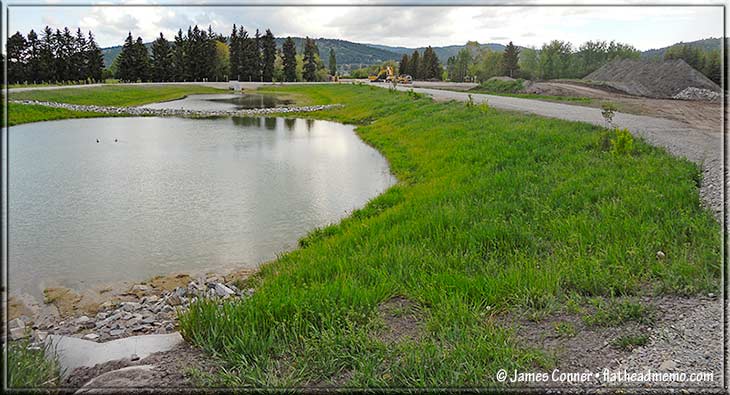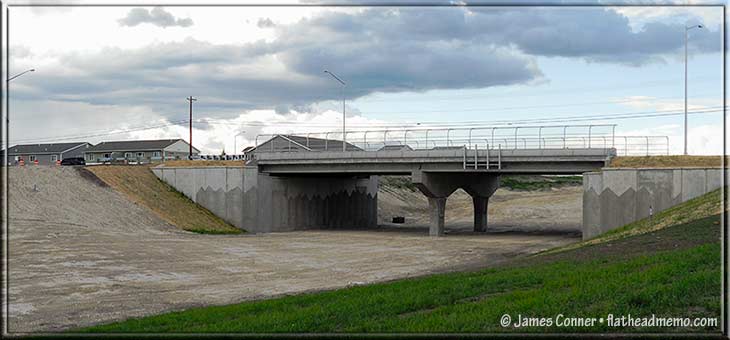Can you imagine paying 36 cents per kilowatt hour of electricity? In the mainland United States? Well, if you buy your electricity from San Diego Gas and Electric, a privately owned utility, reports the Los Angeles Times, that’s what you’ll pay for 2,000 kWhrs a month. But if you’re connected to a municipal electrical utility, you’ll pay approximately half as much.
And if you buy those 2,000 kWhrs/mth from the Flathead Electric Cooperative, you’ll pay approximately a quarter as much.
After running the numbers for FEC, I added them to the table below from the LA Times’ story:

Private utilities in Southern California rely heavily on hydrocarbon fueled thermal plants. Flathead Electric buys most of its power from the Bonneville Power Administration. That’s mostly hydroelectric power from the Columbia River System, which is inexpensive compared to steam plants such as Colstrip.
But FEC’s price for 200 kWhrs a month is higher than both the private and public average of California prices reported by the LA Times. That’s because FEC levies a whopping $22.71 per month base charge on its residential customers. FEC customers who purchase 200 kWhrs a month pay $34.89, which is 17.4 cents per kWhr. FEC power is cheap compared to California power only if you use a lot of it.
Marathons are footraces — only runners should participate in them. Except in the Missoula Marthon. There, a quadriplegic who was allowed to compete in the 2014 race but didn’t like the rules complained to the Montana Human Rights Bureau that the rules were discriminatory.
And the MHRB agreed, reports the Missoulian:
In findings submitted to the bureau last week, investigator Josh Manning sided with Joe Stone, a quadriplegic athlete who has worked with Run Wild Missoula since 2012 so hand-cycle racers can compete in the marathon without prohibitive restrictions.
Stone alleged that Run Wild discriminated against him when it eventually allowed hand cycles in 2014, but imposed speed limits, limited the number of hand cyclists to eight and required them to yield to foot traffic on certain parts of the Missoula Marathon course.
Further, he alleged the hand cyclists couldn’t pass others at certain intervals and had to check in at the race 15 minutes earlier than other athletes.
“Discrimination can take many forms, and even people who believe they are trying to be inclusive and accepting of people with disabilities can create practices or policies that discriminate,” Manning wrote in his investigative report.
Stupidity can take many forms, and the notion that bicycles and wheelchairs should be allowed to compete with runners in a footrace is one of them. The MHRB needs to butt out of this event. Mr. Stone needs to organized a wheeled marathon for disabled athletes.
Yesterday, Jay Stevens, the domain owner at https://4and20blackbirds.wordpress.com, a major blog in Missoula, locked down the website, saying it was time for a reboot because of declining readership and loss of focus on progressive issues:
…The readership has dropped 75 percent in the past year or so, from its high-water marks in 2011 and 2006. And it’s likely a majority of today’s hits are from a few obsessive readers and commenters who check in and post dozens of times a day. But, honestly, with Lee Enterprises cutting its state political bureau, now is the time for informative writing about state and local politics. Now is the time for reasoned views about the critical issues that affect everyday Montanans and Missoulians.
Which is why I put a lockdown on the site for now. It’s time for a reboot.
I don’t know what will happen to the site. I hope it will continue. I’ve asked jhwygirl to step up again, and I think she’s game. We’ll try to recruit new writers, and we’ll keep some of the old ones. But we’ll redirect the site to opinions and news that people need and like.…
Not everyone is happy about this; see the comments.
Last year, I deleted 4and20 from Flathead Memo's blogroll, probably with more fanfare than was strictly necessary. In recent months I sensed a change, and I found myself recommending some reads there.
Stevens is right: with Lee Enterprises retreating from comprehensive coverage of politics and government, quality local political blogs need to step up and fill the vacuum. That’s particularly true now.
The general election of 2016 will be the most important for the nation and Montana since 1932. Should Republicans seize the White House and retain control of Congress, the Affordable Care Act will be repealed. Medicare and Medicaid will be gutted beyond recognition. Social Security will be turned over to Wall Street. Income inequality will increase. The Kochs will be come richer, but the 99 percent will become poorer. That isn’t hysterical prediction: that’s hard, cold fact.
However 4and20 is remade, I wish Jay Stevens, et al, well. They work hard, and whatever their views and focus, they compete in the marketplace of ideas. Our body politic is healthier for it.
This has been a Dust Bowl week, hot, windy, and almost frighteningly dry. A good week for photovoltaics and wind turbines, but a brutal week for lawns, gardens, and farms. My patio flowerpots needed drinks twice a day, and the dirt in a flowerbed on the west side of my house became hard as stone only a few hours after being watered. Today is cooler, but may be the windiest day of the week; the wind is freshening as I write this.
One measure of drought is the streamflow in rivers that are not dammed. In the Flathead, the North and Middle Forks of the Flathead River, are free-flowing. The sum of their flows is a good indicator of how much surface water is available. Below, I’ve plotted the combined flows for 2015, and the drought year of 2001, over the median for the last 75 years. Severe droughts also occurred in 1977, 1944, and 1941 (and before).
The breaks in the 2015 hydrograph are due to missing values for the North Fork. Usually, the culprit is ice. After the water year is completed, the USGS reconstructs the missing data for the published record. The median in the graph was smoothed using a seven-day window.
Sometime near mid-September, possibly in ceremony at solar noon, the Flathead Electric Cooperative will throw a switch sending 83 kilowatts of A.C. electricity generated at its Stillwater photovoltaic farm north of Kalispell coursing into FEC’s powerlines. The Flathead’s first experiment in community solar (NREL PDF) will have begun.
This isn’t news to most of us in the Flathead. There’s a general description of the project in the May, 2015, issue (PDF) of FEC’s newsletter, Light Reading:
A Community Solar Array, which we have branded “SUN” (Solar Utility Network), will be installed near the Stillwater Substation on Whitefish Stage Road in Kalispell, on property already owned by Flathead Electric.
It will consist of approximately 356 solar panels, which total 100kW of output. Currently, work is being done on the design of the system, along with assessments of various cost components. Soon we will be releasing participation details, but the basic premise is that the Co-op will sell sponsorship of the panels.
Each participating member’s monthly output will be metered and they will receive credit for the pro-rated amount of output on their monthly bill. This enables people to participate in solar energy without the large expense of a complete system at their location. It also works for people who don’t have the proper roof orientation or those with shading issues. Watch for the “SUN” to rise this summer!
But there’s much more information in the coop’s request for proposal (PDF, 14 MB), which is posted on the website of the Bonneville Environmental Foundation.
Greg Gianforte, all but certain to run for the Republican nomination for Governor of Montana, is rich, religious, and believes in hard work. But he doesn’t seem to believe in Social Security or even retirement, reports the Huffington Post:
In a February talk at the Montana Bible College about how to find “godly purpose” in work, Gianforte explained why retirement isn’t consistent with biblical teachings.
“There’s nothing in the Bible that talks about retirement. And yet it’s been an accepted concept in our culture today,” he said. “Nowhere does it say, ‘Well, he was a good and faithful servant, so he went to the beach.’ It doesn’t say that anywhere.”
“The example I think of is Noah,” he continued. “How old was Noah when he built the ark? 600. He wasn’t like, cashing Social Security checks, he wasn’t hanging out, he was working. So, I think we have an obligation to work. The role we have in work may change over time, but the concept of retirement is not biblical.”
He’s right about that (and far right, too), but it doesn’t matter. We live in a democracy, not a theocracy. Governor of Montana is a secular office. If elected to it, he won’t get to replace the Montana Constitution and the Montana Codes Annotated with the Bible or the Koran, although he might find that idea appealing.
He might also find being governor the most frustrating job of his life. Business executives, especially successful ones like Gianforte, are accustomed to things being done when they say, “do that.” Successful politicians know the political world doesn’t work that way.
Not only is Gianforte deeply religious, he’s reportedly a young earth fundamentalist (see Bishop Ussher) with particularly rigid religious beliefs. That’s consistent with the world view of an authoritarian personality. His intelligence, sincerity, and work ethic, notwithstanding, he may lack the flexibility, the adaptability, and the empathy for the less fortunate, that successful governing and honoring human rights require.
A headline that survives its author. Back in 1983, a barfly argued with a barkeep at a topless bar, then shot him dead and cut off his head. Vincent Musetto wrote a jackhammer headline for the New York Post: HEADLESS BODY IN TOPLESS BAR. Musetto died today in New York, where the New York Times has a wonderful story on his masterpiece:
But what endured in public memory far longer than the crime was the headline, with its verbless audacity, arresting parallel adjectives and forceful trochaic slams. (The corresponding headline in The New York Times that day proclaimed, genteelly, “Owner of a Bar Shot to Death; Suspect Is Held.” Headlessness was not mentioned until the third paragraph; toplessness not at all.)
Yes, Gary Marbut is involved. When 17-year-old Chet Billi’s citizens initiative to let teachers pack iron in the classroom was announced, I found myself wondering whether Montana’s godfather of permissive firearms laws, Gary Marbut, who loses elections for the legislature but has a knack for persuading legislators to bless his proposed laws, was involved. He was. Sam Wilson has the story at the InterLake.
Backdoor bootstrapping a hate speech law. Last week I wrote a short post on law professor Eugene Volokh’s essay on hate speech prosecution in Montana (the David Lenio case). At the end of that week, the libertarian magazine, Reason, also published an article on what more and more appears to be an attempt to establish a de facto hate speech law in Montana by successfully prosecuting Lenio for violating Montana’s criminal defamation law by Tweeting his belief that the Holocaust never occurred. I now find myself wondering just how much pressure, if any, Montana’s human rights community is putting on the Flathead County Attorney to convict Lenio on the criminal defamation charge.
Remember erstwhile Rep. Jerry O’Neil’s bill to permit corporeal punishment in Montana? The bill that earned him the sobriquet “Floggin’ Jerry?” The bill that probably persuaded the good people of Columbia Falls to replace him with Zac Perry? Well, a case in Saudi Arabia provides a chilling look at how horrific a punishment flogging is. Blogger Raif Badawi:
…who has been imprisoned since 2012, was charged with violating Saudi Arabia’s information technology law and insulting Islam through his website “Saudi Arabian Liberals.”
The lashings are to be carried out 50 lashes at a time, 20 weeks in a row. Badawi endured the first 50 of the 1,000 lashes stoically in January, arching his back in pain. (CNN story.)
This is right out of the Middle Ages, when witches were burned at the stake and blasphemers were punished cruelly simply for uttering opinions that offended deeply religious people. In Christendom, most western nations no longer commit such barbarities, although anti-blasphemy statutes probably remain on the books. Ergo, if Lenio is convicted of criminal defamation for denying the Holocaust, for blaspheming Judaism, he won’t be incinerated while wired to a fencepost, or beaten bloody with wet rawhide whips at high noon in Depot Park. He’ll “only” spend time in the slammer or get fined, or both.
David Lenio has the same human rights as the rest of us, among them the right to make utterances about religion that offend others without suffering incarceration or fines for speaking his mind. It’s time for the Flathead County Attorney to honor those rights and have the criminal defamation prosecution against him dismissed.
At 1000 this morning, Flathead Lake reached 2892.87 on the USGS Gage at Polson. This lake level amounts to de facto, or operational full pool. The license for Kerr Dam allows the lake be raised to 2893, but no higher, and as a practical matter, the lake is kept two or three inches below 2893.
Since April, 1938, Kerr Dam, on the Flathead River below Polson, has regulated the elevation of Flathead Lake. Since October, 1951, Hungry Horse Dam on the South Fork Flathead River has regulated approximately one-third of the inflow to Flathead Lake.
From 1952 through 2014, the lake has risen above 2893.10 just 16 times in the approximately 5,700 days of the summer boating season, nine times during the flood of 1964, six during the flood of 1974, and once in 1990.
Below are graphs displaying the historical norms for the elevation of Flathead Lake, and the history of the lake’s level on 15 June.
Congratulations, Graduates. You made it. Now, make something of yourselves. Be generous. Smile. Laugh. Love. Continue learning. Stay out of jail. Do the right thing because it’s the right thing to do, not because you think you can’t get away with doing the wrong thing. Do these things, and catch a bit of luck, and you will, as Spock would say, live long and prosper.
Ripoffs. Graduating from high school, a once in a lifetime experience that most students and their parents want “done right,” can get expensive, reports the Los Angeles Times:
The expenses at North Hollywood High included a $450 package for a cap and gown, prom ticket, senior class panorama picture, yearbook, letterman jacket and other items. The $400 senior portrait package. The $300 class ring. The $250 prom dress, with another $220 for hair, makeup and nails, $85 for a limousine and $65 for shoes. The $120 for grad night at Disneyland and other expenses.
Overall cost: about $2,225.
That’s pocket change for the rich, empty pockets for the poor, and what I suspect are obscene profits for the vendors who sell class rings and such. Most of that money would be spent better helping the new graduate get a start in life.

Rep. Ryan Zinke brought joy to the timber industry’s hearts this week, introducing H.R.2644, the “National Forest Collaborative Incentive Act of 2015.” On national forests with forest management plans developed through a collaborative process, it puts timbers sales on a fast track to approval, and deters lawsuits by small (almost always local) environmental groups by requiring that they post a bond:
SEC. 202. BOND REQUIREMENT AS PART OF LEGAL CHALLENGE OF CERTAIN FOREST MANAGEMENT ACTIVITIES. (a) Bond Required. — In the case of a forest management activity developed through a collaborative process or proposed by a resource advisory committee, any plaintiff or plaintiffs challenging the forest management activity shall be required to post a bond or other security acceptable to the court equal to the anticipated costs, expenses, and attorneys fees of the Secretary as defendant, as reasonably estimated by the Secretary. All proceedings in the action shall be stayed until the required bond or security is provided.
Requiring a bond is not a new idea, but tying it to management plans developed through collaborative processes is a new twist. And the timber and other resource extracting industries have been trying for years to get around the analysis requirements of the National Environmental Policy Act of 1969 (NEPA).
The collaborative process is political, not scientific. It brings together the so-called reasonable people to reach a largely local consensus on the management objectives for the forest under consideration. But it’s not a substitute for the detailed, project specific analysis that NEPA requires.
Can Zinke’s bill pass? I doubt it. And I doubt he expects it to become law. But it will be good for a hearing in which loggers, mill owners, local officials, and others, testify that citizen lawsuits are closing the forests to responsible management, thus doing economic damage to their communities, and creating a fire hazard, while environmentalists, if any, who testify will be browbeaten, ridiculed, and lectured as though they were juvenile delinquents.
From Zinke’s standpoint, H.R.2644 is good politics. From my standpoint, it’s bad policy that would weaken the environmental review of timber sales while denying practical recourse to the courts to citizens with shallow pockets. The Koch brothers would love it.
Today marks the 71st anniversary of Operation Overlord, the Allied invasion of Nazi occupied Europe. The Longest Day was the theme song for the 1962 movie of that name, which was based on Cornelius Ryan’s 1959 book, The Longest Day. This performance by the Cadet Glee Club of West Point borders on the melodramatic, but the video contains some fine footage of Eisenhower rallying the Allied forces and other images from D-Day. Sharp-eyed viewers will recognize the fleeting view of the memorial at Pointe de Hoc.
An 18-year-old private who landed at Normandy and survived the war would be 89 today. In another decade, very few who were alive that day will still be with us.
Should teachers pack heat? Yes, says Chet Billi, a 17-year-old high school student in Whitefish, reports the Daily InterLake. Upset that the campus carry bill failed in the 2015 MT Legislature, he’s filed an initiative to take the issue to the voters in 2016:
Billi said Thursday he was motivated by a bill rejected by the Montana House this year that would have allowed concealed weapons on college campuses. He says responsible gun owners should be allowed to help prevent mass shootings at schools.
Ergo, armed with a clipboard and a pen (and, let’s hope, nothing more), he’ll take to the streets hunting signatures once he’s a registered voter and the ballot language is approved.
That’s his right, our right, and I applaud his willingness to exercise it. But I do not applaud his notion that students will be safer if their teachers are carrying sidearms.
When I read about Billi’s initiative, an old Tom Paxton song came to mind. I dashed off new lyrics to it in Chet’s honor:
Readers following the case of David Lenio, the man accused of threatening to kill local schoolchildren and of defaming Jews, will want to read Eugene Volokh’s Hate speech prosecution in Montana in today’s Washington Post. Volokh, a conservative libertarian expert on First Amendment law who teaches at UCLA’s law school, concludes:
…the prosecutor has interpreted the Montana criminal defamation statute in a way that I don’t think any criminal defamation statute has been interpreted in decades — a way that risks criminalizing derogatory opinions as well as controversial factual statements about religious groups, racial or ethnic groups, either sex, sexual orientations, professions, political movements, and more.
If the criminal defamation count is upheld, “hate speech” prosecutions (again, even for statements that lack any threat of violence) would become eminently viable. A dangerous potential precedent, and one that I hope the Montana courts will avoid setting.
Regular readers of Flathead Memo know that from the beginning I’ve been skeptical of the charges brought against Lenio, especially the criminal defamation charge. My 21 February 2015 post examined the history of Montana’s criminal defamation statute, which until 1996 said that the truth alone was not an absolute defense.
I thought that given time, Lenio’s prosecutors would quietly drop the criminal defamation charge. Instead, they’re sticking to it, possibly to gain leverage in a plea bargain, possibly to raise a prosecutor’s public profile.
Fortunately, Lenio’s lawyer is fighting back.
Public defender Brent Getty, Lenio’s attorney, moved for dismissal of the charges at a hearing before district judge Heidi Ulbricht on 6 May, reported the Missoulian:
In his motion to dismiss both charges, Getty argues that the statue prohibiting intimidation is unconstitutionally overbroad because it may allow a conviction for speech that does not constitute a “true threat.” The law regarding criminal defamation, Getty says, is also unconstitutionally overbroad because “it allows for conviction of group defamation without a finding of ‘actual malice.’ ”
The intimidation charge, meantime, requires the defendant’s purpose “be directed to an actual person,” Getty writes.
“Despite the efforts of 14 law enforcement officers from three agencies, no alleged victim can be named, because there is no victim,” the motion states. “Nowhere in the affidavit or the tweets is any specific kid, group of kids or school referenced.”
Getty also argues that the intimidation stature requires a defendant to do more than make threats.
I suspect Getty may have brought Lenio’s predicament to Volokh’s attention, directly or indirectly. If so, he did the right thing.
Three Flathead women with concerns over the treatment of Islam in public schools are forming the Truth in Montana Textbooks Association. TMTA does not yet have a website, but spokeswoman Linda Sauer, of Dayton, says one is coming soon, and recommends visiting the Truth in Texas Textbooks website to get a sense of what TMTA’s website might resemble.
Sauer and her colleagues, Davida Constant, Kalispell, and Caroline Solomon, Bigfork, are members of the Flathead chapter of Act! for America, a controversial national organization known for its dim view of Islam and its concerns that American practitioners of Islam may pose a threat to national security. They can be reached at fvactschool@gmail.com.
Sauer, et al, announced in a letter-to-the-editor published in the 2 June Daily InterLake that they were forming TMTA. Referring to a meeting they had with local school superintendents on 14 May concerning the teaching of world religions in local schools, they wrote:
This post updates yesterday’s post on this subject. Heavy rains overnight and today increased the streamflow in the Swan River, and as displayed in the graph below, the river is now above the minimum enforceable flows set in Appendix 26 of the CSKT Water Compact.
The river was below the enforceable hydrograph (MEF) for five days:

In theory, a call on junior water users in the Swan could have begun on 21 May. In practice, especially in these circumstances, with the river still flowing in excess of 2,000 cfs, and only a few percent below the enforceable hydrograph, I doubt a call would be made. The most critical period for fish, I suspect, is in late summer, when the river is low and warm. Even then, flows just a few percent below the enforceable hydrograph might not be enough to trigger a call.
Updated. No one expected this so soon after Montana approved the CSKT Water Compact. Beginning 28 May, the Swan River’s streamflow (discharge) dropped below the Minimum Enforceable Flow set by the compact (Appendix 26 PDF). In theory, once the compact is in force, the CSKT could issue a call on irrigators in the Swan Valley to protect instream flows, but in these circumstances I think it unlikely that a call would be made.
Here’s the hydrograph:
…and at Flathead Memo we’re standing down today to ride bicycles through Kalispell’s northwestern suburbs. We’ll be back online tomorrow unless we hit a French curb.
There are no heroes in the Denny Hastert affair, but there are warnings that our government is keeping a mighty close watch on our money.
First, Denny. Apparently, Hastert, a wrestling coach before he became a politician, was being blackmailed by a former student, evidently a member of the wrestling squad he coached, a male student, an under age male student, with whom he may have had an illicit erotic encounter.
Hastert’s predicament was exposed not because Hastert complained to the authorities that he was being blackmailed, but because Uncle Sam was monitoring Hastert’s cash withdrawals and saw a pattern consistent with evading reporting requirements for large (≥ $10,000) cash withdrawals. When the FBI asked Hastert what he was doing with all that cash, he said he no longer trusted banks. The FBI said, “yeah, right.” Hollywood’s script writers will fight to land the job of scripting that scene.
At that point the jig was up. Hastert should have accused the blackmailer of extortion — the statute of limitations on statutory rape surely has expired — and endured the embarrassment. Instead, he got indicted for lying to the FBI.
Whether the alleged blackmailer will be charged with extortion is not clear. But he certainly should be charged with that crime. Forty years ago he might have been a victim. Now, he’s just a crook.
Uncle Sam and our banking activity. It appears that almost all banking transactions are being analyzed by an algorithm that hunts for transaction patterns that are possible attempts to avoid reporting large cash transactions. The government’s premise is that since money can be moved easily by electronic means, big bundles of greenbacks are prima facie proof of criminal activity. That premise may not be wholly without merit. But I’m not comfortable with the idea that the feds may be monitoring our personal banking activities so closely.
Lee’s diminishing dailies. Pete Talbot, the fine writer who blogs at Intelligent Discontent, comes from a family with a fascinating history in Montana’s newspaper industry, explains in Our Dailies in Death Throes why the slow suicide of the Lee newspapers troubles him so. At Big Sky Words, Greg Strandberg reports on his interview of the Missoulian’s publisher this week. Greg’s blog also should be on your daily read list.
Is Dubya both smarter and more liberal than Jebbie? At Think Progress, attorney Ian Millhiser examines the implications of Jeb Bush’s naming Charles Murray (The Bell Curve) as his favorite author. Murray’s new book, By the People: Rebuilding Liberty Without Permission, Millhiser explains, is for reactionaries who are lawless at heart:
Murray admits that the kind of government he seeks, a libertarian fantasy where much of our nation’s regulatory and welfare state has been dismantled, is “beyond the reach of the electoral process and the legislative process.” He also thinks it beyond the branch of government that is appointed by elected officials. The Supreme Court, Murray claims, “destroyed” constitutional “limits on the federal government’s spending authority” when it upheld Social Security in 1937.
Murray is a reactionary’s reactionary who makes crackpot teabaggers look like thoughtful moderates. Jebbie’s embrace of Murray is not the act of a moderate man.
Incidentally, Millhiser’s new book on the U.S. Supreme Court, Injustices: The Supreme Court’s History of Comforting the Comfortable and Afflicting the Afflicted, is both excellent and depressing.
Should legislators represent just adults, or also babies and little children? At Balkinization, Yale law professor Jack Balkin’s legal blog, Joey Fishkin’s post, Of People, Trees, Acres, Dollars, and Voters, discusses the issues in Evenwel v. Abbott, the Texas case that I noted could affect the composition of Montana’s Indian majority legislative districts. Also on Balkinization, must read posts on the same subject by David Gans and Marty Lederman.

The view south from the Three Mile Drive bypass overpass. The parked machinery is a few hundred feet north of Two Mile Drive. Two ponds are on the left.

Ponds north of Two Mile. At the crossing of Two Mile, the land is low and wet with flowing water.

The Three Mile overpass as seen from the south. There are walkways on both sides of the overpass. At this crossing, traffic can enter or exit the bypass.
After dinner yesterday, I walked the westside Kalispell bypass construction zone from Three Mile Drive to Two Mile Drive. Last year, the Three Mile overpass was built. This year, Montana Department of Transportation officials tell me, they espect construction on the Two Mile overpass to begin in September, after Congress approves the money. Apparently a paved detour (probably vehicles only) will keep Two Mile open while the overpass is built.
When I walked the route, no signs closed the area to visitors. Earth moving and construction machinery were neatly parked. The route obviously is not open to private vehicles, but from Three Mile to Two Mile, the wide graded route is smooth enough for passenger vehicles, and there’s just enough room for a car or small truck west of the flooded tank trap a few hundred feet north of Two Mile:

I’m not looking forward to driving Two Mile during the construction, or after it’s finished. It’s not clear to me whether the overpass will be on the bypass or Two Mile, but either way it will be a dangerous crossing for pedestrians and bicyclists. The money would be better spent widening Two Mile and equipping it with sidewalks.